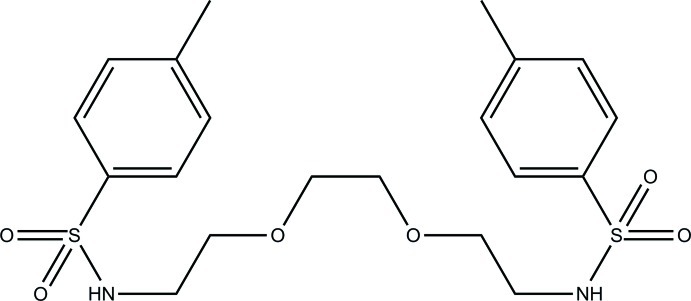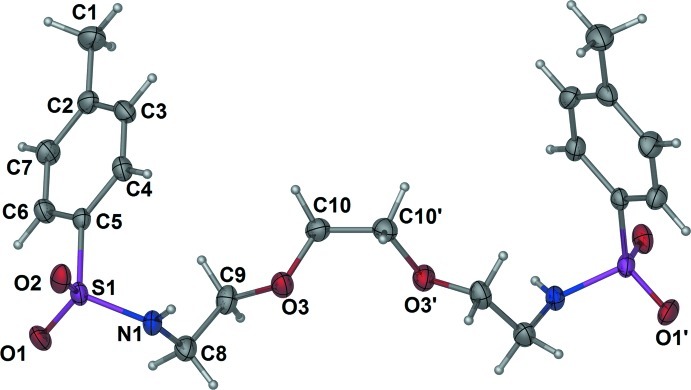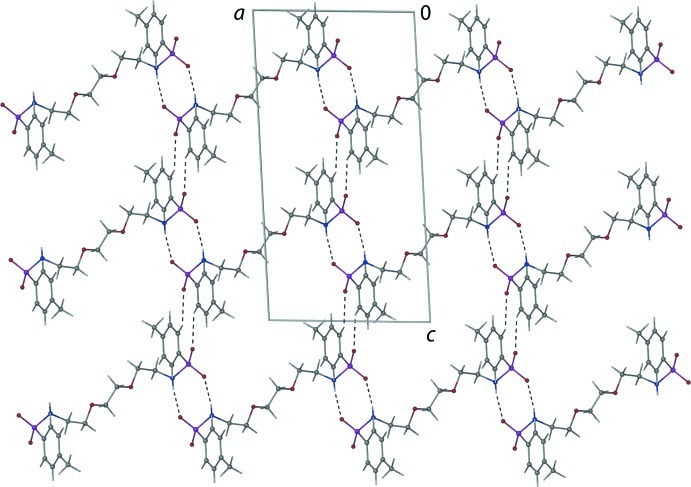Abstract
The asymmetric unit of the title compound, C20H28N2O6S2, contains one half-molecule, related to the other half by a twofold rotation axis. The two aromatic rings of the molecule make a dihedral angle of 50.91 (7)°. The O—CH2—CH2—O and N—CH2—CH2—O fragments both adopt gauche conformations, with torsion angles of 76.0 (4) and 70.4 (3)°, respectively. In the crystal, adjacent molecules are linked through N—H⋯O hydrogen bonds into chains along the a-axis direction. The chains are further connected via C—H⋯O interactions into a two-dimensional supramolecular network in the ac plane.
Related literature
For similar structures, see: Polyakova et al. (1990 ▶); Ding et al. (2003 ▶).
Experimental
Crystal data
C20H28N2O6S2
M r = 456.56
Monoclinic,

a = 11.135 (7) Å
b = 9.220 (6) Å
c = 21.452 (15) Å
β = 93.680 (12)°
V = 2198 (3) Å3
Z = 4
Mo Kα radiation
μ = 0.28 mm−1
T = 296 K
0.23 × 0.14 × 0.04 mm
Data collection
Bruker APEXII CCD diffractometer
Absorption correction: multi-scan (SADABS; Sheldrick, 1996 ▶) T min = 0.938, T max = 0.989
5135 measured reflections
1983 independent reflections
1558 reflections with I > 2σ(I)
R int = 0.055
Refinement
R[F 2 > 2σ(F 2)] = 0.053
wR(F 2) = 0.150
S = 1.03
1983 reflections
140 parameters
1 restraint
H atoms treated by a mixture of independent and constrained refinement
Δρmax = 0.32 e Å−3
Δρmin = −0.36 e Å−3
Data collection: APEX2 (Bruker, 2007 ▶); cell refinement: SAINT (Bruker, 2007 ▶); data reduction: SAINT; program(s) used to solve structure: SHELXS97 (Sheldrick, 2008 ▶); program(s) used to refine structure: SHELXL97 (Sheldrick, 2008 ▶); molecular graphics: X-SEED (Barbour, 2001 ▶); software used to prepare material for publication: SHELXL97 and publCIF (Westrip, 2010 ▶).
Supplementary Material
Crystal structure: contains datablock(s) I, global. DOI: 10.1107/S1600536812024324/pv2551sup1.cif
Structure factors: contains datablock(s) I. DOI: 10.1107/S1600536812024324/pv2551Isup2.hkl
Supplementary material file. DOI: 10.1107/S1600536812024324/pv2551Isup3.cml
Additional supplementary materials: crystallographic information; 3D view; checkCIF report
Table 1. Hydrogen-bond geometry (Å, °).
| D—H⋯A | D—H | H⋯A | D⋯A | D—H⋯A |
|---|---|---|---|---|
| N1—H1⋯O2i | 0.82 (2) | 2.14 (2) | 2.944 (3) | 171 (3) |
| C6—H6⋯O1ii | 0.93 | 2.56 | 3.311 (4) | 138 |
Symmetry codes: (i)  ; (ii)
; (ii)  .
.
Acknowledgments
The authors thank the University of Malaya for funding this study (HIR MOHE (Fakulti) F0004–21001).
supplementary crystallographic information
Comment
The title compound (Fig. 1) was obtained through the condensation reaction of 1,8-diamino-3,6-dioxaoctane with p-toluenesulfonyl chloride. A twofold rotation axis passes through the mid-point of C10—C10' bond (symmetry code: ' = -x + 2, y, -z + 3/2), the asymmetric unit therefore comprises one half of the molecule. The two symmetry related aromatic rings in the molecule make a dihedral angle of 50.91 (7)°. Similar to what was observed in a related structure (Polyakova et al., 1990), the O—CH2—CH2—O and N—CH2—CH2—O fragments adopt the gauche conformations with torsion angles of 76.0 (4) and 70.4 (3)° respectively. The S—O bond distances [1.423 (2) and 1.433 (2) Å] and S—N bond distance [1.608 (2) Å] are comparable to the values found in the literature (Ding et al., 2003; Polyakova et al., 1990). The crystal packing of the molecule shows layers in the ac plane formed by N—H···O and C—H···O interactions (Table 1, Fig. 2)
Experimental
A solution of p-toluenesulfonyl chloride (2.83 g, 1.48 mmol) in dry dichloromethane (25 ml) was added drop wise to a dichloromethane solution (25 ml) of 1,8-diamino-3,6-dioxaoctane (1 g, 0.675 mmol) and triethylamine (2.34 ml, 1.69 mmol) at 273 K. The mixture was stirred at room temperature overnight, washed with water and saturated solution of NaHCO3 (3 x 10 ml) and dried over MgSO4. The organic layer was evaporated and the residue was dissolved in methanol. The colorless crystals of the title compound were obtained through slow evaporation of the methanolic solution at room temperature (m.p. = 361–363 K).
Refinement
C-bound hydrogen atoms were located at the calculated positions and refined in riding mode with C—H distances of 0.93 (aryl), 0.96 (methyl) and 0.97 (methylene) Å. The amino hydrogen atom was found in a difference Fourier map and refined with a distance restraint of N—H 0.86 (2) Å. For H atoms, Uiso(H) were set to 1.2 (1.5 for methyl) Ueq(carrier atoms).
Figures
Fig. 1.
Molecular structure of the title compound with displacement ellipsoids drawn at 30% probability level. Hydrogen atoms are drawn as spheres of arbitrary radius. Symmetry code: ' = -x + 2, y, -z + 3/2.
Fig. 2.
The 2-D array in the ac plane formed by N—H···O and C—H···O hydrogen bonds, depicted as dashed lines.
Crystal data
| C20H28N2O6S2 | F(000) = 968 |
| Mr = 456.56 | Dx = 1.380 Mg m−3 |
| Monoclinic, C2/c | Mo Kα radiation, λ = 0.71073 Å |
| Hall symbol: -C 2yc | Cell parameters from 1589 reflections |
| a = 11.135 (7) Å | θ = 2.9–25.7° |
| b = 9.220 (6) Å | µ = 0.28 mm−1 |
| c = 21.452 (15) Å | T = 296 K |
| β = 93.680 (12)° | Plate, colorless |
| V = 2198 (3) Å3 | 0.23 × 0.14 × 0.04 mm |
| Z = 4 |
Data collection
| Bruker APEXII CCD diffractometer | 1983 independent reflections |
| Radiation source: fine-focus sealed tube | 1558 reflections with I > 2σ(I) |
| Graphite monochromator | Rint = 0.055 |
| φ and ω scans | θmax = 25.3°, θmin = 2.9° |
| Absorption correction: multi-scan (SADABS; Sheldrick, 1996) | h = −13→12 |
| Tmin = 0.938, Tmax = 0.989 | k = −11→11 |
| 5135 measured reflections | l = −17→25 |
Refinement
| Refinement on F2 | Primary atom site location: structure-invariant direct methods |
| Least-squares matrix: full | Secondary atom site location: difference Fourier map |
| R[F2 > 2σ(F2)] = 0.053 | Hydrogen site location: inferred from neighbouring sites |
| wR(F2) = 0.150 | H atoms treated by a mixture of independent and constrained refinement |
| S = 1.03 | w = 1/[σ2(Fo2) + (0.0846P)2 + 0.5056P] where P = (Fo2 + 2Fc2)/3 |
| 1983 reflections | (Δ/σ)max = 0.001 |
| 140 parameters | Δρmax = 0.32 e Å−3 |
| 1 restraint | Δρmin = −0.36 e Å−3 |
Special details
| Geometry. All e.s.d.'s (except the e.s.d. in the dihedral angle between two l.s. planes) are estimated using the full covariance matrix. The cell e.s.d.'s are taken into account individually in the estimation of e.s.d.'s in distances, angles and torsion angles; correlations between e.s.d.'s in cell parameters are only used when they are defined by crystal symmetry. An approximate (isotropic) treatment of cell e.s.d.'s is used for estimating e.s.d.'s involving l.s. planes. |
| Refinement. Refinement of F2 against ALL reflections. The weighted R-factor wR and goodness of fit S are based on F2, conventional R-factors R are based on F, with F set to zero for negative F2. The threshold expression of F2 > σ(F2) is used only for calculating R-factors(gt) etc. and is not relevant to the choice of reflections for refinement. R-factors based on F2 are statistically about twice as large as those based on F, and R- factors based on ALL data will be even larger. |
Fractional atomic coordinates and isotropic or equivalent isotropic displacement parameters (Å2)
| x | y | z | Uiso*/Ueq | ||
| S1 | 0.51163 (5) | 0.03617 (7) | 0.64470 (3) | 0.0440 (3) | |
| O1 | 0.48265 (19) | −0.0655 (2) | 0.59612 (9) | 0.0590 (6) | |
| O2 | 0.41953 (16) | 0.0823 (2) | 0.68398 (9) | 0.0561 (5) | |
| O3 | 0.87638 (18) | 0.0318 (2) | 0.72055 (10) | 0.0567 (6) | |
| N1 | 0.6163 (2) | −0.0329 (2) | 0.69058 (11) | 0.0464 (6) | |
| H1 | 0.614 (3) | 0.002 (3) | 0.7255 (9) | 0.056* | |
| C1 | 0.7115 (3) | 0.5726 (4) | 0.52722 (19) | 0.0769 (10) | |
| H1A | 0.7314 | 0.6430 | 0.5592 | 0.115* | |
| H1B | 0.6528 | 0.6126 | 0.4973 | 0.115* | |
| H1C | 0.7827 | 0.5473 | 0.5066 | 0.115* | |
| C2 | 0.6609 (2) | 0.4389 (3) | 0.55625 (15) | 0.0518 (7) | |
| C3 | 0.6610 (2) | 0.4248 (3) | 0.62001 (15) | 0.0533 (7) | |
| H3 | 0.6933 | 0.4992 | 0.6452 | 0.064* | |
| C4 | 0.6151 (2) | 0.3047 (3) | 0.64781 (13) | 0.0488 (7) | |
| H4 | 0.6153 | 0.2980 | 0.6911 | 0.059* | |
| C5 | 0.5681 (2) | 0.1927 (3) | 0.60972 (12) | 0.0398 (6) | |
| C6 | 0.5678 (2) | 0.2038 (3) | 0.54560 (13) | 0.0512 (7) | |
| H6 | 0.5374 | 0.1288 | 0.5202 | 0.061* | |
| C7 | 0.6131 (3) | 0.3270 (3) | 0.51958 (14) | 0.0594 (8) | |
| H7 | 0.6116 | 0.3352 | 0.4763 | 0.071* | |
| C8 | 0.7215 (3) | −0.1019 (3) | 0.66646 (15) | 0.0578 (8) | |
| H8A | 0.6986 | −0.1426 | 0.6257 | 0.069* | |
| H8B | 0.7461 | −0.1816 | 0.6939 | 0.069* | |
| C9 | 0.8272 (3) | −0.0037 (4) | 0.66034 (14) | 0.0566 (8) | |
| H9A | 0.8873 | −0.0518 | 0.6369 | 0.068* | |
| H9B | 0.8019 | 0.0839 | 0.6381 | 0.068* | |
| C10 | 0.9623 (3) | 0.1465 (3) | 0.72024 (14) | 0.0570 (8) | |
| H10A | 0.9210 | 0.2387 | 0.7150 | 0.068* | |
| H10B | 1.0129 | 0.1338 | 0.6855 | 0.068* |
Atomic displacement parameters (Å2)
| U11 | U22 | U33 | U12 | U13 | U23 | |
| S1 | 0.0341 (4) | 0.0516 (4) | 0.0450 (4) | −0.0066 (3) | −0.0080 (3) | 0.0044 (3) |
| O1 | 0.0642 (13) | 0.0572 (11) | 0.0529 (12) | −0.0192 (10) | −0.0164 (10) | −0.0014 (9) |
| O2 | 0.0341 (10) | 0.0774 (13) | 0.0567 (12) | −0.0015 (9) | 0.0011 (9) | 0.0128 (10) |
| O3 | 0.0480 (11) | 0.0616 (12) | 0.0595 (13) | −0.0071 (9) | −0.0041 (10) | 0.0074 (10) |
| N1 | 0.0402 (12) | 0.0549 (14) | 0.0428 (13) | 0.0016 (10) | −0.0072 (11) | −0.0002 (10) |
| C1 | 0.067 (2) | 0.0605 (18) | 0.102 (3) | −0.0117 (17) | −0.004 (2) | 0.0204 (19) |
| C2 | 0.0369 (14) | 0.0502 (15) | 0.068 (2) | 0.0001 (12) | −0.0021 (14) | 0.0101 (14) |
| C3 | 0.0412 (14) | 0.0467 (14) | 0.071 (2) | −0.0039 (12) | −0.0036 (14) | −0.0096 (14) |
| C4 | 0.0417 (14) | 0.0558 (15) | 0.0478 (16) | −0.0024 (12) | −0.0043 (12) | −0.0049 (13) |
| C5 | 0.0296 (12) | 0.0452 (13) | 0.0440 (14) | 0.0015 (10) | −0.0033 (11) | 0.0013 (11) |
| C6 | 0.0518 (16) | 0.0545 (15) | 0.0463 (16) | −0.0087 (13) | −0.0055 (13) | −0.0009 (13) |
| C7 | 0.0644 (19) | 0.0631 (18) | 0.0499 (17) | −0.0079 (15) | −0.0023 (15) | 0.0103 (14) |
| C8 | 0.0500 (16) | 0.0562 (16) | 0.0658 (19) | 0.0092 (13) | −0.0086 (15) | −0.0111 (15) |
| C9 | 0.0423 (15) | 0.0745 (19) | 0.0526 (18) | 0.0121 (14) | −0.0004 (14) | −0.0021 (15) |
| C10 | 0.0504 (16) | 0.0494 (15) | 0.071 (2) | 0.0000 (13) | 0.0026 (14) | 0.0071 (14) |
Geometric parameters (Å, º)
| S1—O1 | 1.423 (2) | C3—H3 | 0.9300 |
| S1—O2 | 1.433 (2) | C4—C5 | 1.398 (4) |
| S1—N1 | 1.608 (2) | C4—H4 | 0.9300 |
| S1—C5 | 1.761 (3) | C5—C6 | 1.379 (4) |
| O3—C9 | 1.409 (3) | C6—C7 | 1.376 (4) |
| O3—C10 | 1.426 (3) | C6—H6 | 0.9300 |
| N1—C8 | 1.457 (4) | C7—H7 | 0.9300 |
| N1—H1 | 0.816 (17) | C8—C9 | 1.497 (4) |
| C1—C2 | 1.507 (4) | C8—H8A | 0.9700 |
| C1—H1A | 0.9600 | C8—H8B | 0.9700 |
| C1—H1B | 0.9600 | C9—H9A | 0.9700 |
| C1—H1C | 0.9600 | C9—H9B | 0.9700 |
| C2—C3 | 1.374 (4) | C10—C10i | 1.482 (6) |
| C2—C7 | 1.383 (4) | C10—H10A | 0.9700 |
| C3—C4 | 1.372 (4) | C10—H10B | 0.9700 |
| O1—S1—O2 | 119.26 (13) | C6—C5—S1 | 120.5 (2) |
| O1—S1—N1 | 108.00 (13) | C4—C5—S1 | 119.1 (2) |
| O2—S1—N1 | 106.01 (13) | C7—C6—C5 | 119.2 (3) |
| O1—S1—C5 | 107.33 (13) | C7—C6—H6 | 120.4 |
| O2—S1—C5 | 107.22 (13) | C5—C6—H6 | 120.4 |
| N1—S1—C5 | 108.68 (12) | C6—C7—C2 | 121.5 (3) |
| C9—O3—C10 | 112.9 (2) | C6—C7—H7 | 119.2 |
| C8—N1—S1 | 121.6 (2) | C2—C7—H7 | 119.2 |
| C8—N1—H1 | 124 (2) | N1—C8—C9 | 114.9 (2) |
| S1—N1—H1 | 110 (2) | N1—C8—H8A | 108.5 |
| C2—C1—H1A | 109.5 | C9—C8—H8A | 108.5 |
| C2—C1—H1B | 109.5 | N1—C8—H8B | 108.5 |
| H1A—C1—H1B | 109.5 | C9—C8—H8B | 108.5 |
| C2—C1—H1C | 109.5 | H8A—C8—H8B | 107.5 |
| H1A—C1—H1C | 109.5 | O3—C9—C8 | 108.8 (2) |
| H1B—C1—H1C | 109.5 | O3—C9—H9A | 109.9 |
| C3—C2—C7 | 118.2 (3) | C8—C9—H9A | 109.9 |
| C3—C2—C1 | 120.8 (3) | O3—C9—H9B | 109.9 |
| C7—C2—C1 | 121.0 (3) | C8—C9—H9B | 109.9 |
| C4—C3—C2 | 122.2 (3) | H9A—C9—H9B | 108.3 |
| C4—C3—H3 | 118.9 | O3—C10—C10i | 109.8 (2) |
| C2—C3—H3 | 118.9 | O3—C10—H10A | 109.7 |
| C3—C4—C5 | 118.6 (3) | C10i—C10—H10A | 109.7 |
| C3—C4—H4 | 120.7 | O3—C10—H10B | 109.7 |
| C5—C4—H4 | 120.7 | C10i—C10—H10B | 109.7 |
| C6—C5—C4 | 120.3 (2) | H10A—C10—H10B | 108.2 |
Symmetry code: (i) −x+2, y, −z+3/2.
Hydrogen-bond geometry (Å, º)
| D—H···A | D—H | H···A | D···A | D—H···A |
| N1—H1···O2ii | 0.82 (2) | 2.14 (2) | 2.944 (3) | 171 (3) |
| C6—H6···O1iii | 0.93 | 2.56 | 3.311 (4) | 138 |
Symmetry codes: (ii) −x+1, y, −z+3/2; (iii) −x+1, −y, −z+1.
Footnotes
Supplementary data and figures for this paper are available from the IUCr electronic archives (Reference: PV2551).
References
- Barbour, L. J. (2001). J. Supramol. Chem. 1, 189–191.
- Bruker (2007). APEX2 and SAINT Bruker AXS Inc., Madison, Wisconsin, USA.
- Ding, X., Ukaji, Y., Fujinami, S. & Inomata, K. (2003). Chem. Lett. 32, 582–583.
- Polyakova, I. N., Starikova, Z. A. & Tsirkina, O. A. (1990). Kristallografiya, 35, 1284–1287.
- Sheldrick, G. M. (1996). SADABS University of Göttingen, Germany.
- Sheldrick, G. M. (2008). Acta Cryst. A64, 112–122. [DOI] [PubMed]
- Westrip, S. P. (2010). J. Appl. Cryst. 43, 920–925.
Associated Data
This section collects any data citations, data availability statements, or supplementary materials included in this article.
Supplementary Materials
Crystal structure: contains datablock(s) I, global. DOI: 10.1107/S1600536812024324/pv2551sup1.cif
Structure factors: contains datablock(s) I. DOI: 10.1107/S1600536812024324/pv2551Isup2.hkl
Supplementary material file. DOI: 10.1107/S1600536812024324/pv2551Isup3.cml
Additional supplementary materials: crystallographic information; 3D view; checkCIF report




